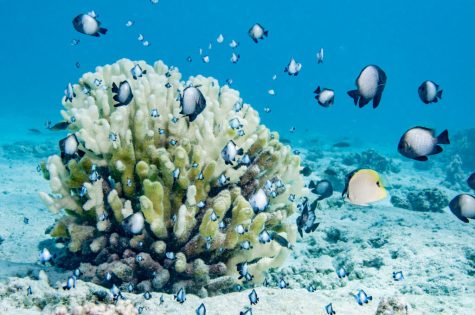Coral Bleaching, the Deadly Yet Ignored Threat
The seen and ignored issue of mass coral reef bleaching, wrecking ecosystems.

A fire coral before and after bleaching. Photo by the XL Catlin Seaview Survey.
What is Coral Bleaching?
Coral Bleaching is when global warming causes the water to warm too much and a part of the
Coral system, the Zooxanthellae, becomes unable to tolerate the temperature. As a result of the intolerance the Zooxanthellae leave the Coral, the Zooxanthellae are however what give the corals their vibrant color and as such the remaining coral structures are left a starch bone white and become ‘bleached.’ Not only that but the Coral and Zooxanthellae have a symbiotic relationship and so when the Zooxanthellae leave the Coral becomes unable to survive and dies off.

Coral Bleaching can also be a result of pollution in the water. If it becomes too cloudy then the Coral becomes unable to filter in sunlight through the murky water and the Zooxanthellae leaves in pursuit of better conditions. These conditions can also happen due to storms kicking up the silt in the water choking out the light, when these conditions happen it tends to kill off entire coral reefs and bleach entire patches. The Coral can also become ‘stressed’ if it’s exposed to any of these conditions to the point of effect but not so severe as to be bleached.
Why is it so devastating?
The death of the Coral affects more than just them, As CKHS AP Environmental Science teacher Dr Bouck put it: “These reefs aren’t just coral you know, their the nurseries for the other fish and animals in the sea” and important nurseries they are indeed, millions of different species of fish, corals, lobsters, clams, sponges and turtles all call the reefs their home.
Coral reefs are what’s called a keystone-species, the others parts of the ecosystem depend on them to help keep the balance within the oceans. Many species outside of the ocean depend on them too, from the birds that feast on fish that spawn, to the packaged lobster at the local Winco. If the Coral collapses then the rest of the ocean follows
“Me personally I’m pretty, really concerned about this,” said CKHS Student, Sooch Handy. “I don’t wanna grow up with this.”
Moving Forward At This Pace
A dangerous aspect to this issue is that once the corals bleach they rarely come back. This is problematic because the growth rate for coral is up to 10 centimeters for branching coral per year and 0.3 – 2 centimeters per year for mature massive corals. At these slow rates the coral cant grow back fast enough to replace what is being lost, many of these massive corals that are being bleached are legacy corals, reef segments that have been building upon themselves for centuries.
The best thing that can be done after repairing the corals is to educate, luckily CKHS has many science programs, ranging from a detailed marine science class to environmental sciences to even an AP Environmental sciences class. The AP environmental science class run by Dr Bouck “take one week aside to focus on ocean acidification and coral bleaching and over fishing and spends one straight class period going over Coral Bleaching” as stated by Dr Bouck the class content goes over the crisis and its adjacent issues in a week long ocean unit.
Frost Pinkerton, a student taking Mr Campbell’s environmental class says; “Everyone should take an enviro class and learn about the world around them, it should be a mandated science class for everyone.”

What Can Be Done For The Coral?
Stressed corals can come back to health if left alone in healthy waters with natural conditions and no ‘stressing factors’ such as heat, chemical pollution, physical particles and silt upkick. A reduction in produced pollutants such as water runoff, storm drains, chemical spills and oil leaks can help to stop bleaching before it occurs.
When asked what they would change about local operations to help oceans student Handy stated; “Making sure that companies have to publicly announce what they are putting into the waters and taking out, making sure they can’t cover their actions through money” an excellent proposal to stop damage from being done at a root point. There are also multiple organized efforts to clean the waters of trash such as The Ocean Cleanup which works to maintain The Largest Clean Up In History.
Not much can be done for already bleached Corals unfortunately, scientists are working to make heat resistant corals to cultivate and preserve our oceans health.


